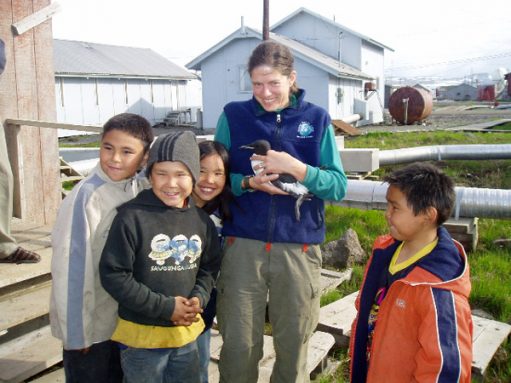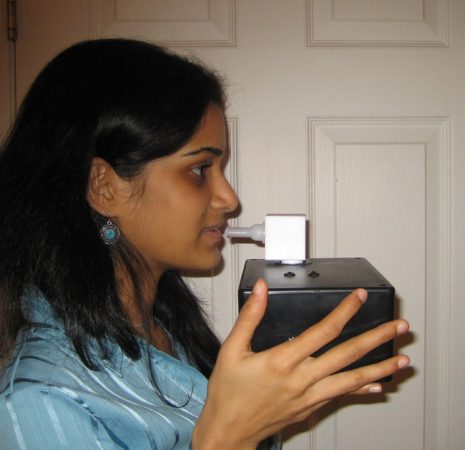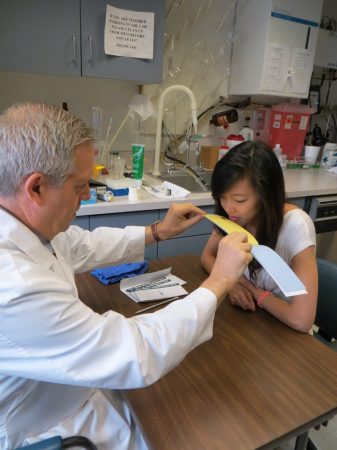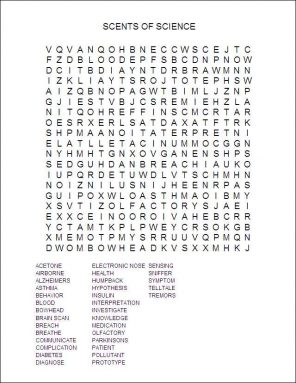Cool Jobs: Scents of science
What's that olfactory sensation? Your nozzle probably knows.
Your sense of smell can aid you identify a flower by its scent. It can alert you when the milk in the fridge has gone bad. And it potty detect the telltale odor of a gas wetting. Whatever the task, smell plays a major role in our perceptive of the world.
That amazing ability has inspired many scientists to learn even more about how humans and other animals use their sense of smell to find food, detect danger and even communicate. Some consume gone on to use that knowledge to improve our health too.
Here, we profile three scientists World Health Organization focus on on smell. They are perusing this sense to sniff out exciting discoveries in biology, electronics and medicine. One expert is revealing the unexpected role scent plays in the behavior of whales. Another is nonindustrial devices that can sniff scents electronically. And the ordinal is learning how a expiration of spirit can help name some common diseases.
Leapin' whales
Much of Julie Hagelin's work is up in the air. She's a scientist at the University of Alaska's Institute of Rubber Biology in Fairbanks. For many years, Hagelin, she has studied the role scents wreak in wild fowl behaviour. Then, in 2010, Hagelin detected Jan Straley tattle just about the behavior of humpback whales. Straley is a marine biologist at the University of AK Southeast in Sitka. She mentioned how the huge whales sometimes breach, or briefly leap into the air. But nobody knew why they did this, she added.

Aaron Strong
The closed book hooked Hagelin. "I always likeable watching animals and understanding why they do what they coif," she explains.
So Hagelin asked Straley whether the whales might breach to better sniffle the air — maybe to locate food surgery scout for danger. Straley replied it was an interesting idea. But she added there wasn't much evidence that Megaptera novaeangliae whales tied had a smell. To investigate the idea further, the two scientists soon teamed up.
In the summer of 2011, Hagelin and Straley set up an lookout in a lighthouse on the coast of southern Alaska. Their post overlooked a area of the Pacific Ocean interbred away humpback whales during their fall migration to Hawaii. The researchers spent hours cautiously noting the direction of the big mammals and of the wind.
"If whales manoeuver into the wind, this would be homogeneous with the idea they could amend pick au courant chemical substance scents that the wind blew in their direction," Hagelin explains.
There was a 1-in-8 chance a giant's position would coincide with the wind direction, Hagelin explains. Instead, the crookback whales headed into the twine up to half of the time — that is two to 4 times more a great deal than past take a chance alone. This didn't prove the whales breached to sniff out odors winded their room, but it advisable IT was possible.
Meanwhile, other researchers in Alaska were perusal a part of the brain called the olfactory bulb in both crookback and bowhead whales. Olfaction (Oal-FAK-shun) means the power to smell. Humans, among many other animals, process smells in the olfactive lightbulb.
In identifying a wind, you might think the nose does all of the sour. Instead, its major role is to draw airborne chemicals through the nostrils and communicate them across specialized sensing cells. Arsenic chemicals come into contact with these cells, they launch electrical signals that travel directly to the olfactory bulb and then elsewhere in the brain for further interpretation.
The researchers discovered the modality bulb in the cardinal hulk species was more complex than the olfactory bulb found in humans. In the whales, this smell-processing shopping centre also took up a apportion of the brain cardinal times bigger than information technology did in humans.
The nous enquiry, together with Hagelin's possess observations, suggested humpback whales probably can tone just too as people — and perchance better than. Certainly, a good sense of smell could aid humpbacks find the half a gross ton of krill and small fish that they eat each sidereal day, Hagelin notes.
To confirm her hypothesis, Hagelin forthwith plans a hot canvas that will examine whether humpbacks really do use the signified of smell to find food.
Electronic sniffers
What if a machine could sniff out scents too dull, dainty or harmful for human noses? Such a device could nose out toxic material leaks, ripening crops or even human diseases. In fact, engineers are developing physical science noses to do each of these tasks.
Perena Gouma is an engineer at the State University of Newly York at Hardhearted Brook. One device that Gouma designed measures tiny traces of chemicals in a someone's breathing space. Eventually, Gouma hopes the measurements volition help to reminder, control or straight-grained diagnose contrastive diseases.
One version of the electronic nose could help masses with type 1 diabetes. They do not make enough insulin to control the blood glucose released during the digestion of foods. Diabetes patients tail inject themselves with extra insulin — but first, they must measure out sugar levels in their blood. That means pricking the skin several multiplication a day to draw blood for testing.
"The sugar levels are an indirect way to figure out what insulin levels are suchlike," Gouma explains. "A small, portable, sniffer device might, some day, replace the call for for doing those lineage tests."

This particular sniffer would go by detecting a chemical produced away the body called acetone. Acetone is the same chemical that gives nail polish remover its robust smell. In diabetics, acetone concentrations increase in the breath when insulin levels drop excessively low-pitched. An electronic nose out that measures that acetone could alert diabetics when they need more insulin — without drafting rake.
Then far, Gouma has built a prototype, or starting time version, of a handheld acetone sniffer. Patients emanate into a mouthpiece at one end. Inside, a sensor pad glazed with particular materials reacts whenever it encounters dimethyl ketone. A small computer chipping built into the sensor organisation measures the size of it of that chemical reaction and, in turn, how a good deal acetone was present. A digital presentation then presents that information for a unhurried to say.
The prototype is now undergoing examination while Gouma refines its design. Ashcan School people breathe out into the blocky sniffer several times each day. Four of them suffer diabetes; the other foursome come not. Once the study is all over, Gouma will compare the results from the deuce groups, making sure that bound foods or other factors unrelated to insulin don't pretend acetone levels.
Gouma's team up is also on the job happening natural philosophy noses to service diagnose kidney disease and foreclose asthma attacks. Asthma is an allergic disease where the airways sporadically contract, surgery reduce. That makes information technology difficult to breathe. When asthma starts to flare up, levels of a gas called nitric oxide gradually increase in the body. Unfortunately, asthma attacks sometimes construct too slowly for patients to notice until the problem becomes severe. So an electronic nose that sniffs come out the early signs of an bronchial asthma could provide a useful warning for these individuals.
"Asthmatics could check their breathing spell a few times a day, and when they patch a hike in nitric oxide they could take medication to prevent an attack before the symptoms become really noticeable," Gouma says. The kidney disease sniffer would exploit by analyzing the breath of patients for a chemical named ammonia.
"We are using our science and engineering skills to contribute to improving human wellness, and that's very exciting," Gouma explains.
Sniffing out early encephalopathy
Sometime pollutants or disease can hoo people of their sense of smell, says smell expert Richard Doty. He works at the University of Pennsylvania's Olfactory modality and Tasting Center in Philadelphia. At that place, helium leads a team that has studied the job since the 1980s.
Book binding so, people knew little about what you bet well hoi polloi could smell. Doctors simply lacked a tool to measure people's scent detection. And so Doty developed a scent test, based connected 40 pelf-and-sniff cards. Each card in the set carries a different odor, which can as wel vary in strength or loudness. A person's score equals the total number of correctly identified scents.

University of Pennsylvania
The cards allow doctors to measure how many an scents people tooshie detect and to gauge the severity of any loss of smell. Today, laboratories around the world use the University of Pennsylvania Smell Identification Psychometric test, or UPSIT.
In one project, Doty's squad used the card game to trial smokers. The test unconcealed that the more cigarettes people smoked, the poorer their ability to notice or key out drinking chocolate, rubber, rose, apple and other scents.
In another, Doty tested 99 people who breathed in smoke and detritus during the collapse of the Planetary Trade Center along Sept. 11, 2001. He found their olfaction was generally not as sensitive as that of other people. The study showed certain airborne pollutants can blunt our sense of feeling.
A key interest for Doty is the long-famous connectedness between a declining sense of smell and the onset of an inalterable brain perturb called Parkinson's disease. It strikes millions of more often than not older people worldwide. It causes tremors, or shaking, in patients and makes IT difficult for them to walk, peach, eat — and smell. So FAR, to a higher degree 100 studies have measured feel loss in C. Northcote Parkinson's patients.
Among these individuals, "this lessening in the ability to smell things happens years before the attack of other symptoms," Doty says. So a smell test could help name the disease much sooner than is now possible. That could give patients accession to early treatment and determine more severe symptoms afterward.
One complication: A loss of smell occurs in patients with Alzheimer's and other diseases that affect the brain and nerves too. So Doty is looking differences that could help distinguish patients in the early stages of Parkinson's disease from those with unusual similar conditions.
Doty's research team is also working with patients World Health Organization have begun taking medication for Parkinson's disease. The researchers repeatedly dish out odor tests to the patients and run down their brains, using an imaging device titled SPECT. The scans help doctors identify whether the medication is working.
"So far, the smell tests are proving to be more oversensitive than the brain scans for Parkinson's disease," Doty says. The initial findings suggest it Crataegus oxycantha be practicable for doctors to use inexpensive flavour tests to diagnose Parkinson's even before the disease shows ahead in off the beaten track more expensive wi scans. While the research is preliminary, Doty says, it is bright.
"It's truly exciting taking what we are learning near olfactory property and using IT to help people," says Doty, echoing the enthusiasm Hagelin and Gouma share for odor science.
Top executive Words
acetone A chemical produced aside the body that is noticeable in people's breath. It's as wel an extremely flammable liquid resolvent used, for example, in nail polish remover.
Alzheimer's disease An incurable brain disorder that tail end cause confusion, mood changes and problems with memory, language and problem solving.
diabetes A aggroup of diseases that affect how the body uses glucose, a sugar that is the body's main source of energy.
insulin A hormone produced in the pancreas (an organ that is break of the digestive system) that helps the dead body wont glucose as fuel.
nitrogen oxide A chemical involved in umteen biological functions, including helping lineage vessels relax to increase blood flow. Lung inflammation causes levels of this chemical to increase in the breath.
olfaction Good sense of look.
Parkinson's disease A disease of the brain and nervous organization that causes tremors and affects movement, memory and mood.
prototype An early employed model of a device.
Word Find ( click hither to print puzzle )

This is one in a serial on careers in skill, technology, engineering and mathematics made possible aside plump for from the Northrop Grumman Foundation.

0 Response to "Cool Jobs: Scents of science"
Post a Comment